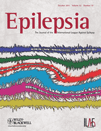Risk and prognostic factors of status epilepticus in the elderly: A case–control study
Summary
Purpose: The aim of this study was to assess the risk and prognostic factors of status epilepticus (SE) among elderly inpatients.
Methods: From May 2003 to April 2005, 63 consecutive patients aged 70 years or older with SE were included. Each patient was matched to three controls without SE seen during the same period. Matching variables were age (±3 years), gender, and comorbidity index (±3). Multivariate logistic regression model were used to compare cases to controls and, among the cases, nonsurvivors to survivors.
Key Findings: By multivariate analysis, factors independently associated with SE were acute decompensation (cardiac, respiratory, or hepatic) [adjusted odds ratio (ORa) 2.57, 95% confidence interval (95% CI) 1.05–6.25] history of epilepsy (ORa 3.93, 95% CI 1.27–12.14), chronic cerebrovascular disease (ORa 7.96, 95% CI 3.31–19.15), nonvascular dementia (ORa 4.16, 95% CI 1.86–9.29), and dysnatremia (ORa 5.08, 95% CI 2.34–11.04). In-hospital 1-month mortality was 2.3 times higher among cases than controls (14/63, 22.0%; 95% CI 12.7–34.5%; vs. 18/189, 9.5%; 95% CI 5.7–14.7%; p = 0.01). Among the cases, factors independently associated with in-hospital death within 1 month were younger age (ORa per 1-year increase 0.87, 95% CI 0.76–0.98), higher comorbidity index (ORa per 1-point increase 1.27, 95% CI 1.07–1.55), and de novo SE (ORa 14.95, 95% CI 2.24–192.8).
Significance: Independent predictors of SE in hospitalized patients aged 70 years or older were acute decompensation (cardiac, respiratory, or hepatic), history of epilepsy, chronic cerebrovascular disease, nonvascular dementia, and dysnatremia. Factors that independently predicted death in patients with SE were younger age, higher comorbidity index, and de novo SE.




